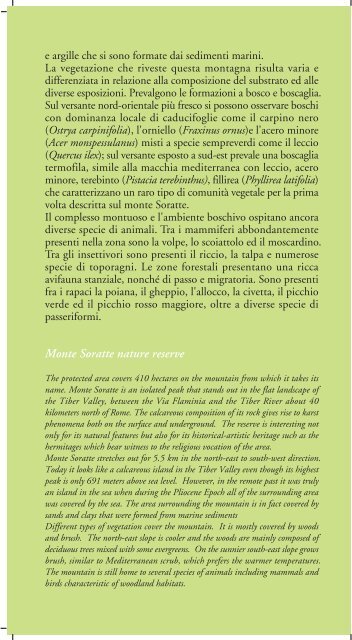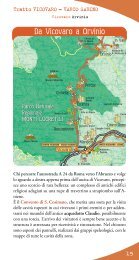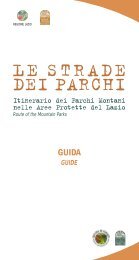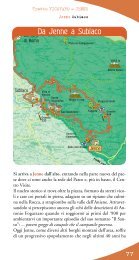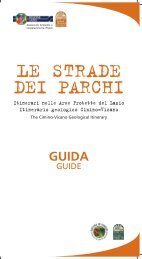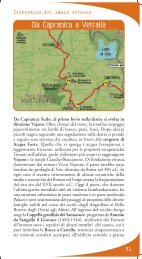Scarica la guida in PDF - Le Strade dei Parchi
Scarica la guida in PDF - Le Strade dei Parchi
Scarica la guida in PDF - Le Strade dei Parchi
Create successful ePaper yourself
Turn your PDF publications into a flip-book with our unique Google optimized e-Paper software.
e argille che si sono formate dai sedimenti mar<strong>in</strong>i.<br />
La vegetazione che riveste questa montagna risulta varia e<br />
differenziata <strong>in</strong> re<strong>la</strong>zione al<strong>la</strong> composizione del substrato ed alle<br />
diverse esposizioni. Prevalgono le formazioni a bosco e boscaglia.<br />
Sul versante nord-orientale più fresco si possono osservare boschi<br />
con dom<strong>in</strong>anza locale di caducifoglie come il carp<strong>in</strong>o nero<br />
(Ostrya carp<strong>in</strong>ifolia), l'orniello (Frax<strong>in</strong>us ornus)e l'acero m<strong>in</strong>ore<br />
(Acer monspessu<strong>la</strong>nus) misti a specie sempreverdi come il leccio<br />
(Quercus ilex); sul versante esposto a sud-est prevale una boscaglia<br />
termofi<strong>la</strong>, simile al<strong>la</strong> macchia mediterranea con leccio, acero<br />
m<strong>in</strong>ore, tereb<strong>in</strong>to (Pistacia tereb<strong>in</strong>thus), fillirea (Phyllirea <strong>la</strong>tifolia)<br />
che caratterizzano un raro tipo di comunità vegetale per <strong>la</strong> prima<br />
volta descritta sul monte Soratte.<br />
Il complesso montuoso e l'ambiente boschivo ospitano ancora<br />
diverse specie di animali. Tra i mammiferi abbondantemente<br />
presenti nel<strong>la</strong> zona sono <strong>la</strong> volpe, lo scoiattolo ed il moscard<strong>in</strong>o.<br />
Tra gli <strong>in</strong>settivori sono presenti il riccio, <strong>la</strong> talpa e numerose<br />
specie di toporagni. <strong>Le</strong> zone forestali presentano una ricca<br />
avifauna stanziale, nonché di passo e migratoria. Sono presenti<br />
fra i rapaci <strong>la</strong> poiana, il gheppio, l'allocco, <strong>la</strong> civetta, il picchio<br />
verde ed il picchio rosso maggiore, oltre a diverse specie di<br />
passeriformi.<br />
Monte Soratte nature reserve<br />
The protected area covers 410 hectares on the mounta<strong>in</strong> from which it takes its<br />
name. Monte Soratte is an iso<strong>la</strong>ted peak that stands out <strong>in</strong> the f<strong>la</strong>t <strong>la</strong>ndscape of<br />
the Tiber Valley, between the Via F<strong>la</strong>m<strong>in</strong>ia and the Tiber River about 40<br />
kilometers north of Rome. The calcareous composition of its rock gives rise to karst<br />
phenomena both on the surface and underground. The reserve is <strong>in</strong>terest<strong>in</strong>g not<br />
only for its natural features but also for its historical-artistic heritage such as the<br />
hermitages which bear witness to the religious vocation of the area.<br />
Monte Soratte stretches out for 5.5 km <strong>in</strong> the north-east to south-west direction.<br />
Today it looks like a calcareous is<strong>la</strong>nd <strong>in</strong> the Tiber Valley even though its highest<br />
peak is only 691 meters above sea level. However, <strong>in</strong> the remote past it was truly<br />
an is<strong>la</strong>nd <strong>in</strong> the sea when dur<strong>in</strong>g the Pliocene Epoch all of the surround<strong>in</strong>g area<br />
was covered by the sea. The area surround<strong>in</strong>g the mounta<strong>in</strong> is <strong>in</strong> fact covered by<br />
sands and c<strong>la</strong>ys that were formed from mar<strong>in</strong>e sediments<br />
Different types of vegetation cover the mounta<strong>in</strong>. It is mostly covered by woods<br />
and brush. The north-east slope is cooler and the woods are ma<strong>in</strong>ly composed of<br />
deciduous trees mixed with some evergreens. On the sunnier south-east slope grows<br />
brush, simi<strong>la</strong>r to Mediterranean scrub, which prefers the warmer temperatures.<br />
The mounta<strong>in</strong> is still home to several species of animals <strong>in</strong>clud<strong>in</strong>g mammals and<br />
birds characteristic of wood<strong>la</strong>nd habitats.


